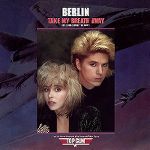 Now, you may be looking at this pic to the left right now and wondering what on earth these three people have to do with Pink Floyd, but we'll get to that part later. Some exposition needs to be taken care of first.
Now, you may be looking at this pic to the left right now and wondering what on earth these three people have to do with Pink Floyd, but we'll get to that part later. Some exposition needs to be taken care of first.Their career now following a hopeful upward trajectory, Berlin had achieved a mainstream breakthrough in 1984 thanks to the single "No More Words" which had nearly cracked the Top 20 of the Billboard Hot 100 that spring. However, this breakthrough had come at a cost: the confidence of their leader, bass player and primary songwriter John Crawford. The pressure on Crawford to succeed had been mounting ever since Berlin made their unlikely breakthrough in 1983, a surge in popularity which was equally attributable to a) being the right band in the right place at the right time, and b) the all-powerful promotional element of controversy.
It was around February of 1983 that Berlin's debut EP Pleasure Victim, recorded on the cheap and initially released on the independent label Enigma (before being picked up for distribution by then-newbie Geffen Records), suddenly became a hot property. At first, all of the commotion surrounding the band was due to the absurdly button-pushing lyrics sung by Crawford and lead singer Terri Nunn on the single "Sex."
 While it might seem comparatively tame by modern lyrical standards, the relentless, seedy porno movie atmosphere of the track combined with such immortal lines as "Slip and slide in your wet delight, feel the blood flow" and "Wrap your legs around mine and ride me tonight " caused a full-blown national epidemic of hand-wringing only recently matched by a certain wardrobe malfunction at some football game early last year. No, I jest -- barely anyone heard "Sex" since only a handful of stations in the United States would even touch it, but those who did hear it spread the word and the band found themselves attaining a national cult following, which then mushroomed considerably following the release of the similarly pulsating (but much more radio-friendly) europop of "The Metro." With a crucial assist from tastemaker MTV (who gave the track virtually blanket airplay during the second third of 1983), as well as an appearance at the 1983 US Festival, Berlin suddenly found themselves poised for stardom.
While it might seem comparatively tame by modern lyrical standards, the relentless, seedy porno movie atmosphere of the track combined with such immortal lines as "Slip and slide in your wet delight, feel the blood flow" and "Wrap your legs around mine and ride me tonight " caused a full-blown national epidemic of hand-wringing only recently matched by a certain wardrobe malfunction at some football game early last year. No, I jest -- barely anyone heard "Sex" since only a handful of stations in the United States would even touch it, but those who did hear it spread the word and the band found themselves attaining a national cult following, which then mushroomed considerably following the release of the similarly pulsating (but much more radio-friendly) europop of "The Metro." With a crucial assist from tastemaker MTV (who gave the track virtually blanket airplay during the second third of 1983), as well as an appearance at the 1983 US Festival, Berlin suddenly found themselves poised for stardom. Released the following spring, the Mike Howlett-produced Love Life represented a compromise of sorts between Crawford and the powers that be at Geffen Records, who had now become the band's full-time landlords. When first presented with the album masters, the label wasn't overly enthusiastic with the results and wondered where the hit single was. To help in this process, Geffen tapped noted disco producer George Moroder and his protegé Richie Zito to produce a couple of rejected songs from the Howlett sessions -- "No More Words" and "Dancing In Berlin." The results of that idea, as mentioned above, was the band’s first verifiable major hit. Score one for Geffen.
Released the following spring, the Mike Howlett-produced Love Life represented a compromise of sorts between Crawford and the powers that be at Geffen Records, who had now become the band's full-time landlords. When first presented with the album masters, the label wasn't overly enthusiastic with the results and wondered where the hit single was. To help in this process, Geffen tapped noted disco producer George Moroder and his protegé Richie Zito to produce a couple of rejected songs from the Howlett sessions -- "No More Words" and "Dancing In Berlin." The results of that idea, as mentioned above, was the band’s first verifiable major hit. Score one for Geffen.While Crawford may have been understandably upset that Geffen was already focused on recouping their investment and turning Berlin into a hits machine rather than letting the band grow at their own pace, he certainly couldn't argue with the commercial results of Moroder and Zito's interaction, either: in comparison to "No More Words," the Howlett production "Now It's My Turn" peaked at a lowly No. 74. Love Life also didn't maintain its sales pace for long -- despite being certified gold, the album represented a drop off from the platinum sales level achieved by its predecessor.
It was during 1985 that, according to Crawford, Berlin was adrift without a rudder. Instead of listening to where his heart thought the band's music should be going, Crawford began listening to what other people (namely, record executives and producers) were telling him instead. After all, he reasoned, they were right about "No More Words," weren't they? Writing on his recently-started website, Crawford attributes the dismissal of guitarist Ric Olsen, as well synth players Matt Reid and David Diamond (the latter a key collaborator in the band's early sound) during this period to the musical uncertainty and additional pressure to succeed spawned by Love Life. As the founding member of Berlin, Crawford was fiercely protective of his position as the leader, even though he was increasingly relying on the consultations of others who were now steering him away from the sound of "The Metro" and towards a more mainstream rock feel. With the three "other" members gone, and the band now down to a core trio of Crawford, Nunn and drummer Rob Brill, it was time for Berlin to make a move to the much-vaunted "next level."
 As it turns out, that "next level" was reached the following year when Berlin appeared on the soundtrack to the movie Top Gun. One of the great "synergistic" marketing exercises of the decade, Top Gun absolutely dominated the summer of 1986 in movieplexes, and was matched in success by its Big 80's bonanza of a soundtrack album. Specifically engineered to be a monster, Top Gun performed beyond even the highest expectations of Columbia Records: released in May of 1986, it ran over the competition like a bulldozer, spending over a month at number one on Billboard's album chart, staying listed on said chart for 93 weeks (i.e., all the way through 1987 and even into 1988) and selling somewhere north of 9 million copies.
As it turns out, that "next level" was reached the following year when Berlin appeared on the soundtrack to the movie Top Gun. One of the great "synergistic" marketing exercises of the decade, Top Gun absolutely dominated the summer of 1986 in movieplexes, and was matched in success by its Big 80's bonanza of a soundtrack album. Specifically engineered to be a monster, Top Gun performed beyond even the highest expectations of Columbia Records: released in May of 1986, it ran over the competition like a bulldozer, spending over a month at number one on Billboard's album chart, staying listed on said chart for 93 weeks (i.e., all the way through 1987 and even into 1988) and selling somewhere north of 9 million copies.Perhaps moreso than any other record from that time period, the Top Gun soundtrack is one of those "guilty pleasures" that is filed well out of sight these days by people who wish to keep their musical reputations in one piece (cough cough). The shame with owning up to liking Top Gun isn't so much the songs themselves being so brainlessly, diabolically catchy, but the production on the album itself. Talk about a record that just screams 1986 -- Top Gun was loaded down with some of the most cheesetastic production values to ever grace a soundtrack album, mixed red-hot and designed to be cranked up louder than hell on your IROC-Z stereo system.
 It should be noted that Top Gun was as its sales peak at the same time that Berlin's contribution "Take My Breath Away," was riding high on mutliple charts worldwide. A stately synth ballad that, like everything else on Top Gun, sounded impossibly huge on the radio, "Take My Breath Away" was an immediate across-the-board smash that took the band all the way to the #1 position on the Hot 100 and provided the kind of "new album setup" most bands (or labels) would kill for. However, even moreso than their experience with "No More Words," this success was highly tainted. Most crushingly for the increasingly-unsure Crawford, "Take My Breath Away" was not really a Berlin song at all - it was simply Terri Nunn singing a song produced and arranged by Georgio Moroder (him again!) and written by Moroder and Tom Whitlock. Crawford and Brill did not even perform on the track, and aside from the wall-to-wall synths, "Take My Breath Away" had little in common with Berlin's material, old or new. One wonders exactly why it was credited to Berlin at all.
It should be noted that Top Gun was as its sales peak at the same time that Berlin's contribution "Take My Breath Away," was riding high on mutliple charts worldwide. A stately synth ballad that, like everything else on Top Gun, sounded impossibly huge on the radio, "Take My Breath Away" was an immediate across-the-board smash that took the band all the way to the #1 position on the Hot 100 and provided the kind of "new album setup" most bands (or labels) would kill for. However, even moreso than their experience with "No More Words," this success was highly tainted. Most crushingly for the increasingly-unsure Crawford, "Take My Breath Away" was not really a Berlin song at all - it was simply Terri Nunn singing a song produced and arranged by Georgio Moroder (him again!) and written by Moroder and Tom Whitlock. Crawford and Brill did not even perform on the track, and aside from the wall-to-wall synths, "Take My Breath Away" had little in common with Berlin's material, old or new. One wonders exactly why it was credited to Berlin at all.Still, with an international #1 single to kick off the proceedings, Geffen figured they had a guaranteed smash on their hands and released Berlin's second full length album Count Three And Pray a month later. Representing a near-total change in musical direction for the band, Count Three And Pray featured Nunn's increasingly-assured and dynamic vocals in a setting not terribly unlike the songs on the Top Gun soundtrack -- thick beds of rock guitar chords and glistening synth chords pinned down by that intricately-created, larger than life 1980's drum-and-bass sound that was all the rage in those days (best evidenced on the track "Heartstrings"). There was also a lot of well known names on hand to lend assistance (Ted Nugent, Elliot Easton, Patrick O'Hearn, Kane Roberts), thanks to the considerable rock credentials of producer Bob Ezrin.
 Despite the seemingly can't-miss nature of the project and a good critical reception, Count Three And Pray was a bitter failure commercially. It seemed that radio was not at all interested in the much louder and more strident sounds of the band's first new music in two and a half years. In fact, the album's first single, a galloping slice of upbeat pop called "Like Flames" barely made it to #82 before disappearing in less than a month and no other songs from the project were ever able to reverse the band's suddenly nose-diving momentum. Count Three And Pray itself managed to sleepwalk around the album chart for 3 months, but never cracked the Top 60 while doing so. You have to wonder if Geffen was thinking maybe we should have sicced Moroder on this one, too ...
Despite the seemingly can't-miss nature of the project and a good critical reception, Count Three And Pray was a bitter failure commercially. It seemed that radio was not at all interested in the much louder and more strident sounds of the band's first new music in two and a half years. In fact, the album's first single, a galloping slice of upbeat pop called "Like Flames" barely made it to #82 before disappearing in less than a month and no other songs from the project were ever able to reverse the band's suddenly nose-diving momentum. Count Three And Pray itself managed to sleepwalk around the album chart for 3 months, but never cracked the Top 60 while doing so. You have to wonder if Geffen was thinking maybe we should have sicced Moroder on this one, too ...While Geffen was bitterly disappointed by the public's rejection of Count Three And Pray, the band themselves were devastated. Perhaps unsurprisingly, things fell apart quickly in the early part of 1987, and the band effectively ceased to exist after Terri Nunn departed for the solo career the label figured she was destined for in the wake of "Take My Breath Away." The last official release from Berlin after that was a decent best-of album released for the Christmas 1988 sales rush. End of story.
Crawford and Brill bounced back almost immediately (at least in artistic sense) with their next project, The Big F. Functioning as pure catharsis for Crawford after the flameout of Berlin, The Big F was a blistering alternarock/metal hybrid that was intended as an angry upraised middle finger to the music industry (thus the subtle band name) and received about the level of promotion you would expect for such a project on a major label (a subsequent Big F release on a different label met a similar fate in 1993).
Surprisingly, Nunn's solo career crashed and burned on startup in 1992 when she released The Moment Of Truth. A year later, following the dissolution of The Big F, Crawford and Nunn made an abortive attempt to write music together once again, but Crawford's disillusionment with the music industry at that point ultimately rendered the reunion moot. End of story again.
Ah, but in 1996, Berlin magically reunited as a totally new (and apparently very Goth-friendly) lineup fully under Nunn's control (this followed her acquisition of the Berlin name following some name-ownership dealings with Crawford that left the two at odds for years). A live album of this new lineup featuring a couple of newly-written songs and titled Sacred And Profane tested the commercial waters for this new lineup and apparently found them good (though sales were a fraction of the albums done by the "classic lineup"). In 2002, Voyeur , the first studio album credited to Berlin in sixteen years appeared in record stores. While researching this article, I also became aware during a visit the reconstituted band's website of a brand new Berlin album apparently being released on July 5 -- an all-covers effort, cheekily titled 4play.
Now for that Pink Floyd connection I was talking about ... while producing Count Three And Pray with the band in 1986, Bob Ezrin was also starting work with guitarist David Gilmour on what would become Pink Floyd's first album since the departure of Roger Waters: A Momentary Lapse Of Reason. To keep himself in playing shape over the intervening years since The Final Cut and his About Face album and tour, Gilmour had become an in-demand session player on various albums by artists like Bryan Ferry, Pete Townshend and Arcadia. While most of his guest appearances on these albums are pretty easily recognizable to any Gilmour fan, perhaps his greatest non-Floyd guitar solo appeared on the epic ballad "Pink And Velvet," the final track on Count Three And Pray. Let loose for nearly three minutes over the song's extended outro, Gilmour lays down a breathtaking, fiery solo that at times brings to mind his fretwork on "Comfortably Numb" and on the future Floyd classic "On The Turning Away."

No comments:
Post a Comment